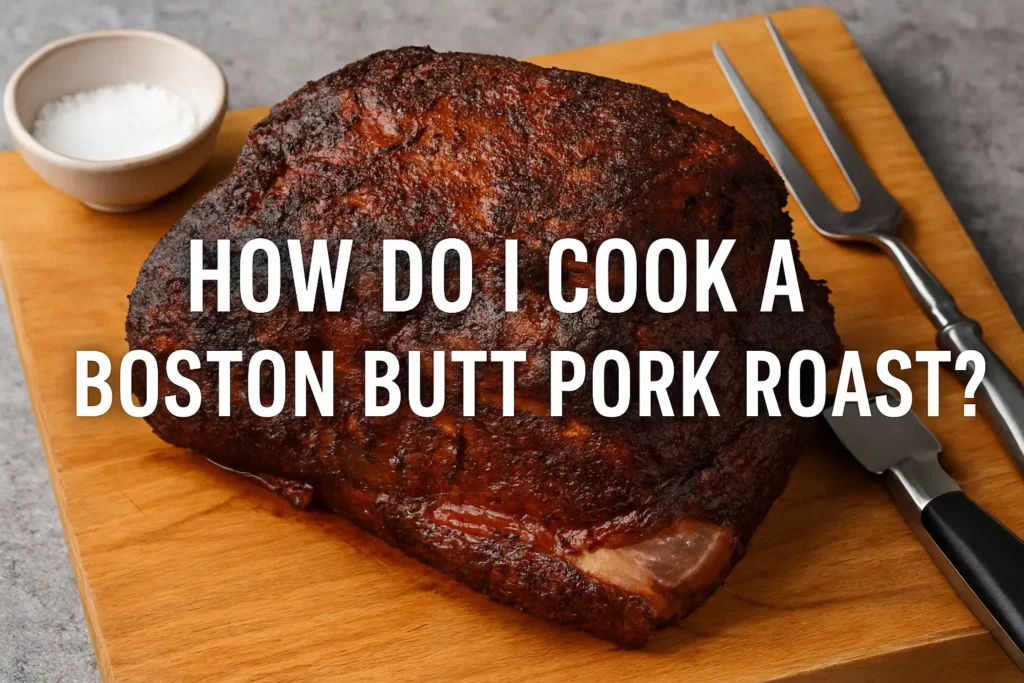This post may contain affiliate links. If you use these links to buy something we may earn a small commission. Thanks.
There’s something undeniably comforting about a slow-cooked pork roast filling the house with its rich, savory aroma. Whether you’re planning a weekend feast, a family get-together, or just craving melt-in-your-mouth pulled pork, a Boston butt roast is one of the most flavorful and versatile cuts you can cook.
But what exactly is a Boston butt? Despite its name, it has nothing to do with a pig’s backside. It’s actually cut from the upper portion of the shoulder. With its marbling, connective tissue, and hearty flavor, it’s tailor-made for low and slow cooking methods.
In this guide, we’ll walk you through everything you need to know from choosing the best cut to cooking it in the oven, slow cooker, smoker, or even pressure cooker. By the end, you’ll be able to turn a humble piece of pork into a show-stopping dish.
What Is Boston Butt Pork Roast?
The Boston butt also called pork shoulder or pork butt is a cut from the upper part of the pig’s front leg. Despite the confusing terminology, it’s not from the rear end of the animal. The name “butt” actually dates back to colonial New England, where pork shoulders were stored in barrels called “butts.”

This cut is prized for its:
- High fat content: Which renders beautifully during slow cooking.
- Abundance of collagen: Perfect for creating juicy, tender pulled pork.
- Versatility: Works well roasted, braised, smoked, or slow-cooked.
Most Boston butts weigh between 4 and 10 pounds, making them ideal for feeding a crowd or for multiple meals throughout the week.
Choosing the Right Boston Butt
Before you even fire up your oven or grill, it’s important to start with the right cut. Here’s what to look for:
1. Bone-In vs. Boneless
- Bone-In: Tends to be more flavorful and stays juicier. The bone helps conduct heat and adds richness.
- Boneless: Easier to carve and cook a bit faster, but may dry out more easily if overcooked.
2. Size
Plan for about ½ to ¾ pound of uncooked meat per person. For pulled pork, you’ll lose about 30–40% of the weight during cooking.
| People Served | Recommended Weight |
|---|---|
| 4–6 people | 4–5 lbs |
| 8–10 people | 7–8 lbs |
| 12+ people | 9–10 lbs |
3. Fresh vs. Frozen
- Fresh pork is ideal for flavor and texture.
- Frozen is perfectly fine but must be thawed fully in the refrigerator this can take up to 2–3 days depending on the size.
4. Quality of Pork
- Heritage breeds (like Berkshire or Duroc) are more flavorful.
- Look for pork with good marbling and a pinkish color.
- Avoid overly pale or gray meat with little fat.
Prepping the Roast
The prep work can make or break your roast. Here’s how to set yourself up for success:
1. Thawing the Roast
If frozen, let it thaw slowly in the refrigerator over 48–72 hours. Never thaw at room temperature.
2. Trimming (Optional)
You can trim excess fat if your roast has more than ¼ inch of fat cap. Don’t remove all of it the fat helps keep the meat juicy.
3. Seasoning
Choose between:
- Dry Rub: A classic mix of salt, pepper, garlic powder, paprika, cayenne, onion powder, and brown sugar.
- Wet Marinade: Use a mix of apple cider vinegar, mustard, olive oil, Worcestershire, and seasonings.
Rub or marinate the pork at least 4 hours before cooking ideally overnight in the fridge.
4. Let It Rest Before Cooking
Take the roast out of the fridge about 1 hour before cooking to let it come to room temperature. This helps it cook more evenly.
Cooking Methods
Depending on your time, equipment, and flavor preference, there are several methods to cook a Boston butt.
A. Oven-Roasted Boston Butt
One of the most reliable ways to prepare pork shoulder without special equipment.
Instructions:
- Preheat oven to 275°F.
- Place the seasoned pork in a roasting pan or Dutch oven.
- Add a bit of broth, cider, or water to the pan (about ½ cup).
- Cover with foil or a lid to keep it moist.
- Roast for 90 minutes per pound, until the internal temperature reaches 195–205°F.
- Remove foil in the last hour to let the outside crisp up.
- Let rest 20–30 minutes before shredding.
Pros:
- Simple and hands-off
- Great flavor and texture
Cons:
- Takes several hours
B. Slow Cooker (Crockpot)
Perfect for busy days when you want to “set it and forget it.”
Instructions:
- Add a thin layer of BBQ sauce, apple cider, or broth to the bottom.
- Place seasoned pork on top.
- Cover and cook on low for 8–10 hours or high for 5–6 hours.
- Check for doneness at 195°F. It should fall apart easily.
- Shred, mix with sauce, and serve.
Pros:
- Foolproof and flexible
- Keeps the meat ultra-moist
Cons:
- Lacks crispy bark unless finished in oven
C. Smoked Boston Butt
The gold standard for BBQ lovers. Smoking gives it a rich, deep flavor and beautiful bark.
Instructions:
- Preheat smoker to 225–250°F.
- Use wood chunks or chips—hickory, apple, or cherry are best.
- Place the roast fat-side up in the smoker.
- Spritz every 1–2 hours with apple juice or cider vinegar.
- Smoke for 1.5–2 hours per pound.
- At 160°F internal temp, wrap in foil or butcher paper (optional but helps push through the “stall”).
- Continue smoking until 195–205°F.
- Rest wrapped in a towel in a cooler for 1 hour.
Pros:
- Deep, smoky flavor
- Amazing bark and crust
Cons:
- Requires time and attention
- Needs a smoker or grill setup
D. Pressure Cooker (e.g., Instant Pot)
A quick and convenient method with great results.
Instructions:
- Cut pork into large chunks for even cooking.
- Sear pieces with sauté function (optional).
- Add 1 cup of broth, cider, or BBQ sauce.
- Lock lid and set to high pressure for 60–90 minutes.
- Let pressure release naturally.
- Shred meat and toss with juices or sauce.
Pros:
- Done in under 2 hours
- Perfect for busy nights
Cons:
- Lacks crispy bark
- Smaller batches only
Internal Temperature and Doneness
Cooking Boston butt is all about internal temperature not time.
Temperature Guidelines:
- Safe to Eat (per USDA): 145°F
- Ideal for Pulled Pork: 195–205°F
- Shredding Texture: At 200°F+, the collagen breaks down and the meat becomes pull-apart tender.
Resting Is Crucial:
Let your roast rest 20–30 minutes after cooking. This allows juices to redistribute and fibers to relax for better texture.
Serving Suggestions
Once your pork is done and beautifully shredded, the possibilities are endless:
1. Pulled Pork Sandwiches
- Serve on brioche or potato buns
- Top with coleslaw and drizzle with BBQ sauce
2. Tacos or Nachos
- Use seasoned pulled pork in tacos
- Add queso, guac, and pickled onions
3. Southern BBQ Plates
- Serve with baked beans, mac and cheese, and cornbread
4. Pork Over Rice or Mashed Potatoes
- Add pan drippings as gravy
- Top with herbs or hot sauce
Storing and Reheating Leftovers
Refrigerating:
- Store shredded pork in airtight containers
- Use within 4 days
Freezing:
- Freeze in 1–2 cup portions in freezer bags
- Label and date—good for 3 months
Reheating:
- Add broth or BBQ sauce before reheating to retain moisture
- Microwave, stovetop, or oven-safe dish all work well
Pro Tips for Perfect Boston Butt
- Don’t rush it: Low and slow always wins.
- Let it rest: Don’t skip this step—it’s vital for tenderness.
- Use a meat thermometer: This removes all the guesswork.
- Save the juices: Skim the fat and use as a sauce base.
- Finish in oven: Want a crispy crust? Pop it under the broiler for 5–10 minutes.
Conclusion
Cooking a Boston butt pork roast is more than just putting meat in the oven it’s a slow, rewarding journey that ends in a plate of succulent, flavorful pork that falls apart with a touch.
Whether you roast it, smoke it, slow-cook it, or pressure cook it, the key lies in patience, temperature control, and seasoning. With this guide, you’re now equipped with the tools and techniques to cook a Boston butt roast that’s juicy, tender, and unforgettable.
So, fire up that oven, plug in the smoker, or set your slow cooker your perfect pork roast awaits.
